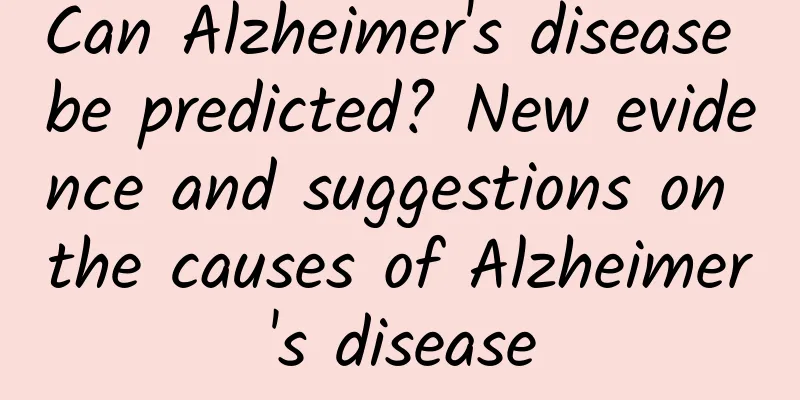Can Alzheimer's disease be predicted? New evidence and suggestions on the causes of Alzheimer's disease

|
New evidence and suggestions on the causes of Alzheimer's disease ----Imbalance of human microecology, diet and lifestyle are all related to Alzheimer's disease Author: Xiao Yongliang Member of the popular science expert team of the Chinese Nutrition Society, health lecture expert in Gansu Province, former part-time professor at the School of Public Health of Lanzhou University, graduate tutor, etc. [Alzheimer's disease is a headache for scientists all over the world? After the 2017 Chinese New Year of the Rooster, this question has been on my mind for a long time. The reason is very simple. More and more of my old classmates, old comrades-in-arms and the elders in my hometown have been concerned about and consulted about Alzheimer's disease. Therefore, I started to look up information and take notes, which can be regarded as the beginning of preventing Alzheimer's disease. Now I would like to share with you the "new evidence and tips on the cause of Alzheimer's disease". ] 1. A disease that causes headaches and sighs for scientists all over the world - senile dementia (Alzheimer's disease) . With the increasing aging of the global population, senile dementia has become a disease that has caused headaches and sighs for scientists around the world. In 1906, German doctor Alois Alzheimer discovered the disease and named it Alzheimer disease (AD) after him. AD clinically manifests as memory loss, persistent cognitive decline, and movement disorders, accompanied by a series of psychiatric symptoms. It is very stubborn and difficult to treat. No effective method has been found to cure the disease so far. The disability and mortality rates are extremely high, and the number of patients is increasing year by year. It has become the fourth killer after cardiovascular disease, tumors and stroke. The current research and medical level has no way to prevent and cure it, and there is no way to slow down its deterioration, which has brought a heavy burden to society and families. It has become a serious social problem and a disease that threatens the quality of life and health of the elderly. AD is a persistent degenerative disease of the central nervous system with intellectual impairment. The incidence of AD in the elderly over 65 years old has been increasing steadily at a rate of 0.5% per year, and that in the elderly over 85 years old has been increasing at a rate of 8% per year. Data show that the prevalence rate is about 5% for those over 65 years old and 20% for those over 85 years old. The prevalence rate in women is about three times that in men. It is generally believed that the prevalence rate will double with every increase of 5 years of age. Starting from the early manifestation of short-term memory loss, it gradually develops into the loss of brain nerve cell function, memory, judgment, sense of orientation, attention and language ability, and the patient cannot take care of himself, accompanied by changes in behavior and personality that seriously affect social, occupational and life functions. Since the vast majority of AD patients have not been diagnosed and cannot obtain long-term and effective special care or treatment, most patients die within 5-10 years. According to the 2016 annual report of Alzheimer's Disease International (AD International), as a neurodegenerative disease that occurs frequently in the middle-aged and elderly population, more than 47 million people are currently suffering from AD, and it is expected to reach 131 million by 2050. It also has a huge economic impact. AD brings pain to patients and heavy psychological and economic burdens to families and society, which undoubtedly means that more than one trillion yuan of treatment and nursing expenses need to be invested. Most people mistakenly believe that the incidence of AD in my country is lower than that in Western countries. The main reason is that people have always believed that memory loss is part of human aging, not a disease, and rarely go to the hospital for treatment. A large-scale AD survey in my country showed that its incidence is similar to that in developed countries in Europe and the United States, and the incidence of AD is significantly higher than VD (vascular dementia). The pathogenesis of AD is very complex. It is currently believed that there are more than 100 factors that can cause AD, including both genetic factors and acquired environmental influences and inductions. The pathogenesis is not very clear. According to different causes, senile dementia can be roughly divided into 5 categories. ① Degenerative dementia, such as Alzheimer's disease, Lewy body dementia, Parkinson's disease dementia, frontotemporal dementia, etc.; ② Vascular dementia (Vascular Dementia, VD); ③ Metabolic disorder dementia; ④ Infection-related dementia, such as neurosyphilis, AIDS, prion disease, etc.; ⑤ Substance toxicity dementia, etc.; About 80% of senile dementia patients are AD and VD. As the research deepens, the causes of these five types of AD all point to the outcome of pathological changes in brain nerve tissue, namely, extracellular senile plaques formed by the deposition of β-amyloid protein, and neurofibrillary tangles in nerve cells formed by the hyperphosphorylation of abnormal TDP-43 and Tau proteins. It is confirmed that these three proteins and neuronal loss accompanied by glial cell proliferation play an important role in AD and are the main pathological diagnostic features of AD. However, where is the source of the pathological changes of TDP-43, amyloid plaques and Tau protein misfolding? 2. New evidence of the cause of Alzheimer's disease Tip: Alzheimer's symptoms can be transferred to healthy young organisms through the intestinal microbiota, which means that the intestinal flora of patients with Alzheimer's disease can be transmitted to healthy people; human microecological imbalance can be used as an important indicator for AD diagnosis and treatment. New evidence has been found in the field of AD research and treatment, suggesting that human microecological imbalance can be used as an important indicator for AD diagnosis and treatment (Journal of Alzheimer's Disease, 2016-03-08). Recently (October 18, 2023), an article published in Brain entitled Microbiota from Alzheimer's patients induce deficits in cognition and hippocampal neurogenesis confirmed for the first time the causal role of intestinal microbiota in Alzheimer's disease, and that symptoms of Alzheimer's disease can be transferred to healthy young organisms through intestinal microbiota. Microecological imbalance is associated with direct nutritional imbalance, and microecological imbalance leading to pathogenic microbial infection is an important chain factor that has been overlooked, opening up new paths for the treatment of AD. Imbalanced diet and nutrition may lead to imbalance in microecology, which may be one of the pathogenic factors of AD. The genome and related biochemical reactions of intestinal flora affect the health of the host, including metabolism, immunity, development and behavior, and imbalance in flora will lead to related diseases; the interaction between the host and the flora is carried out through the metabolites secreted by the flora, which have a significant impact on the host's physiology; the immune system constantly patrols the metabolic state and colonization state of the flora in the intestinal microenvironment; the metabolites of the flora have an important regulatory effect on the host immune system. Combining various research results, the following is a summary of the researchers' evidence that dietary imbalance leads to imbalance in microecology and AD. 2.1 Evidence on the relationship between diet and lifestyle and AD 2.1.1 Intestinal flora affects the growth of microglia Tip: The importance of a balanced diet to brain health. Many studies have shown that brain microglia play an important role in diseases such as Parkinson's disease and AD. In January 2017, Nature Neuroscience reported that microglia have the special function of repairing damaged brain tissue and are called "brain doctors." Researchers at the University of Freiburg in Germany discovered for the first time that intestinal bacteria in experimental mice can control the maturation process and function of microglia in the brain. 2.1.2 Constipation can cause AD. Tip: Long-term accumulation of these toxins in the body is a hidden danger of AD. Elderly people who have chronic constipation for a long time are at high risk of developing AD. Surveys show that as the probability of constipation increases, intelligence test scores decrease, and the probability of AD constipation is 1.5 times higher than that of ordinary elderly people. About 6 out of every 100 residents in my country often suffer from constipation, and this proportion rises to 10% among people over 60 years old. Many toxins formed after the bacteria in the intestines break down proteins will enter the blood circulation. When the toxins accumulated in the body exceed the detoxification capacity of the liver, they enter our brain and damage the central nervous system, eventually leading to a decline in the intelligence of the elderly and even causing Alzheimer's disease. Especially for the middle-aged and elderly, chronic constipation should not be taken lightly. People have this experience: the more meat you eat, the more smelly your stool becomes. The reason is that you consume too much protein. The protein that cannot be digested by the human body will be decomposed by E. coli in the intestines and produce 3-methylindole (skatole), indole, hydrogen sulfide, amines, etc. These substances are the cause of the smelly stool. These substances are collectively called toxins in feces. 2.1.3 Chronic diseases and unhealthy lifestyles can cause AD. Tip: Diabetes, high cholesterol and smoking may increase the incidence of AD; Mediterranean diet, folic acid intake, reduced alcohol consumption, and maintaining brain and body health can help reduce the risk of AD. A study by the National Institutes of Health in the United States showed that diabetes, high cholesterol and smoking may increase the prevalence of AD; Mediterranean diet, folic acid intake, reduced alcohol consumption, and keeping the brain and body healthy seem to help reduce the risk of AD. However, the evidence is not enough to give a definite answer. 2.1.4 Exercise can reduce the risk of mild cognitive impairment (MCI) and AD by 50% Tip: People who exercise regularly have less Aβ deposits in their brains. A recent RCT (randomized controlled trial) (Scolosser 2015) on the intervention of physical exercise on MCI patients found that not only cognitive scores were improved, but also indicators such as sMRI (structural imaging), fMRI (functional imaging), and cerebrospinal fluid biomarkers were also improved. It can also increase the translation expression of protective genes in the body and correct the damage to cognition caused by risk factors such as diabetes, sleep disorders, and depression. Another epidemiological study showed that aerobic exercise for more than 6 months can significantly increase the volume of the hippocampus and improve memory function. AD-related cerebrospinal fluid biomarkers are associated with a sedentary lifestyle, and C-PIB PET imaging shows less Aβ deposition. A large number of animal experiments have found that physical exercise protects the brain and cognition through multiple mechanisms, including: increased neuronal activity, promotion of the release of brain trophic factors (such as BDNF), repair of damaged cerebral blood vessels, reduction of stress/inflammatory response, and reduction of Aβ deposition. 2.2 Evidence of human microecological imbalance and senile dementia Tip: With the deepening of research, we have realized the existence and functional importance of the human "bacterial organ" - the human microecological system. The study of the microecological system has opened up new ways for human health, longevity, disease prevention and treatment. In 1991, scientists first discovered herpes simplex virus 1 (HSV1) in the brains of people who died of AD, opening the door to research on the relationship between the human microbiome and AD. 2.2.1 Evidence on the relationship between microecological imbalance and AD 2.2.1.1 There are some pathogens in the brains of AD patients, such as HSV1. When infected with HSV1 virus or bacteria, mice or cells show typical pathological characteristics of β-amyloid protein deposition and Tau protein folding. β-amyloid precursor protein (AβPP) directly interacts with HSV1. Antiviral drugs can prevent HSV1 from causing the formation of abnormal Aβ and Tau proteins in in vitro experiments. According to serum test results, HSV infection is associated with the exacerbation of AD virus. 2.2.1.2 One of the early symptoms of AD is olfactory impairment. The olfactory nerve is located outside the entorhinal cortex and is the initial area where AD brain neurons are lost. Studies have speculated that this area may be the initial location where HSV1 and other viruses enter the brain and begin to infect, leading to olfactory problems. 2.2.1.3 Inflammatory reactions have always been present in the characteristics of Alzheimer's disease cases. Pathological features similar to AD have been found in human brains infected with viruses such as AIDS and herpes. Studies have confirmed that pathological features in clinical syphilis cases are associated with Helicobacter pylori and syphilis. 2.2.1.4 AD Compared with controls, AD brains have higher levels of lipopolysaccharide (LPS) and Escherichia coli K99 flagellar antigen protein. Animal studies have shown that bacterial LPS plus local ischemia/hypoxia increase β-amyloid protein and generate aggregates similar to amyloid plaques. 2.2.1.5 Most elderly people have viruses and other microorganisms lurking in their brains. Although most of them are dormant, they may "wake up" once stress, immunosuppression and other conditions intensify. 2.2.1.6 Herpes simplex encephalitis (HSE) causes damage to brain areas that control memory, cognition, and emotions, similar to symptoms of Alzheimer's disease. 2.2.1.7 The APOE gene involved in immune function has been confirmed to be associated with AD. Genome-wide association studies have shown that other immune system components, including viral receptor genes, may further develop into AD pathogenic factors. 2.2.1.8 Cases of Alzheimer’s disease transmission have been found in model animals such as primates and mice. Although there are many studies, it is still not enough to prove that microecological imbalance causes AD, and the statement that AD can be transmitted through microorganisms is also difficult to convince. The author believes that the series of infection problems caused by microecological imbalance have put forward a higher theoretical demand for the relationship between microecology and infection. After microorganisms enter the brain through the blood, they are in a latent period. Once activated by internal and external environments such as immunity and stress, they will directly damage brain cells or trigger secondary inflammatory reactions, leading to neuronal degeneration and death. Infections caused by microecological imbalance are very common in clinical practice. Infections, chronic diseases, the use of antibiotics, chemotherapy, organ transplantation, interventional therapy and other advanced medical methods can lead to intestinal microecological imbalance. For example, while antibacterial drugs kill pathogenic bacteria, they also kill beneficial bacteria, which can induce intestinal bacterial translocation. In severe cases, enterogenic infections occur, leading to intestinal microecological imbalance. It is hoped that more research on the correlation between microbial infection and AD will be carried out. 3. Prevention, intervention and treatment of Alzheimer's disease 3.1 Prevention and treatment of Alzheimer's disease The bad news Tip: Searching for anti-AD drugs with therapeutic effects has become a hot topic in current drug development. In recent years, basic research in neurophysiology, biochemistry and pharmacology has continued to deepen, and the development of AD drugs has made phased progress, but most of them are still concentrated in preclinical research. Several highly anticipated Phase III clinical new drugs such as Pfizer's Latrepirdine and Eli Lilly's Semagacestat have failed one after another, forcing researchers to re-examine the strategy of developing AD drugs. The understanding of the pathogenesis of AD and the defects in diagnosis will affect the selection of drug targets and the design of clinical programs. Current first-line AD treatments, such as acetylcholinesterase (AChE) inhibitors, can only alleviate cognitive impairment in early-stage patients and provide modest symptom improvement, but cannot stop the progression of the disease. Researchers believe that although countless studies have investigated risk factors and possible treatments for Alzheimer's disease, there are still large gaps in research knowledge (Martha Daviglus, Archives of Neurology). 3.2 Good news about the prevention and treatment of Alzheimer’s disease 3.2.1 Long-term use of the diabetes drug pioglitazone reduces the incidence of AD Tip: AD may be related to neuroinflammation. A large-scale six-year study in Germany involving more than 145,712 subjects aged 60 and above without AD and other ADs showed that a reduced risk of AD was closely associated with taking pioglitazone, a drug that inhibits neuroinflammation. 3.2.2 Regular physical exercise helps reduce AD Tip: Regular exercise can help reduce the risk of AD. A study of 280 adults in the United States (average age 81 years) found that those who exercised moderately in middle age had a significantly reduced risk of mild cognitive impairment. In a second survey of exercise frequency and intensity in 1,830 cognitively normal adults, it was found that those who exercised lightly in middle and late age had a reduced risk of mild cognitive impairment, just like those who exercised vigorously in middle age and those who exercised moderately in late age. A multicenter RCT study by Jerry D Edwards of the University of South Florida, which included 2,832 non-dementia residents with an average age of 73.6 in the community, showed that the risk of dementia in the elderly who received more than 10 sessions of systematic training was even reduced by 48%. 3.2.3 Lifestyle intervention may improve memory and thinking in middle-aged and elderly people Tip: Lifestyle intervention can help improve brain health. A two-year randomized controlled clinical trial in Finland showed that a structured program of multiple changes in life factors can improve memory and thinking in elderly people with cognitive impairment and AD risk. 1,260 elderly people, ranging in age from 60 to 77 years old, were divided into two groups. One group received interventions such as nutritional guidance, physical exercise, cognitive learning, social activities, and management of heart health risk factors, while the control group only received conventional health advice. After two years, the intervention group was significantly better than the control group in all aspects of memory and thinking. An independent study of 329 middle-aged people with normal cognition who were either genetically predisposed or had a family history of AD found that engaging in mentally stimulating activities in middle age could help protect them from developing AD in old age. The study found that participants who reported frequent activities, such as reading, visiting museums, and especially playing intellectual and card games, tended to get higher test scores in memory and thinking challenges, such as planning, judgment, and problem solving. They also had greater capacity in several brain regions associated with AD. 3.2.4 Delayed hypertension may protect people from AD Tip: Good blood pressure control is beneficial for AD. Although having high blood pressure in middle age may increase people's risk of developing AD, new evidence shows that the association between high blood pressure and the risk of Alzheimer's disease may change over time and even help protect people aged 90 and above from Alzheimer's disease. A US study showed that a 10-year follow-up survey of 625 elderly people without AD found that those with high blood pressure aged 80-89 had a significantly lower risk of developing AD compared with participants without a history of high blood pressure. And those with high blood pressure aged 90 and above have a lower risk of developing AD. 3.2.5 Probiotics and cognitive function in patients with Alzheimer’s disease Tip: Probiotics can significantly improve the cognitive function of the human brain, bringing hope for the prevention and treatment of AD. For the first time, it was discovered that probiotics can improve cognitive function in the human brain. Researchers from Islamic Assad University and other institutions reported their first discovery in the international journal Frontiers in Aging Neuroscience. This clinical study lasted for 12 weeks and recruited 52 men and women aged 60 to 95 with Alzheimer's disease. A randomized, double-blind clinical study was conducted and divided into an experimental group and a control group. The experimental group consumed 200 ml of milk rich in four probiotics (Lactobacillus acidophilus, lactic acid bacteria, yeast and bifidobacterium, each containing about 400 billion probiotics) every day, and the control group consumed milk without probiotics. The results showed that the MMSE questionnaire scores of the experimental group increased significantly from 8.7 to 10.6 points, while the scores of individuals in the control group decreased from 8.5 to 8.0 points. Although there were individuals in the probiotic treatment group whose scores did not increase significantly, and all patients still maintained cognitive impairment, the results of this study are very important. Researcher Professor Mahmoud Salami said that previous studies have found that probiotic therapy can improve impaired spatial learning and memory in the brains of diabetic rats. This study is the first to find that probiotic additives may improve individual cognitive function in human patients with cognitive impairment. Probiotic-based therapy may be able to reduce the levels of triglycerides, very low-density lipoproteins and C-reactive protein in the blood of Alzheimer's patients. 4. New recommendations from the World Alzheimer's Report 2023 The report presents key case studies focused on reducing the risk of dementia and provides truly global insights into the way dementia risk factors are identified around the world. 4.1. In the absence of a cure or widely available treatments, risk reduction remains the most feasible and proactive approach to preventing and treating dementia. 4.2. Just as there are rarely simple answers to a complex problem, there are no magic solutions to dementia. But there are practical steps, big or small, that individuals can take to reduce their risk, and any step is better than no step. 4.3. Eat as healthily as possible - eat a variety of foods and avoid ultra-processed foods. There are many ways to eat healthily, and a personalised diet combining local and affordable foods that suits your needs is best. 4.4. Exercise - Exercise creatively, such as walking, cycling, Tai Chi, dancing... 4.5. Keep learning - Challenge your brain, whether it's learning a new language, doing crossword puzzles, singing songs... 4.6. Pay attention to your cardiovascular health status and any other chronic diseases. 4.7. Stay connected - Humans are social animals, and socializing can improve our brain health and reduce depression and loneliness. 4.8. Take care of general physical maintenance - check your dental health, avoid head injuries, make sure you get enough sleep, and don't smoke or drink too much alcohol. 4.9. A potentially game-changing step would be to give people with hearing loss hearing aids, which have not only been shown to slow cognitive decline but are also cost-effective and scalable. 5. Summary There are still many difficult problems in the field of AD: Does β-amyloid need to be completely eliminated? What is the "culprit" that causes memory loss and cognitive decline? Do infections such as viruses and bacteria cause AD? ... Solving these puzzles will inevitably require more energy and funds. Whether voluntarily or not, we need to face dementia, have a balanced diet, exercise properly, have a calm mind, maintain a good lifestyle, and move the threshold of preventing AD forward again and again, because the number of patients has been increasing. References: 1. Microbiota from Alzheimer's patients induce deficits in cognition and hippocampal neurogenesis, Brain, 2023;,awad303, https://doi.org/10.1093/brain/awad303 2.Jerri D Edwards, University of South Florida, Tampa, FL, USA. The ACTIVE Study: What We Have Learned and What Is Next? 2016 AAIC, Toronto, July21-28. 3. Laura D Baker, PhD, Wake Forest University Health Sciences, Winston Salem, NC, USA. Exercise and Memory Decline. 2016 AAIC, Toronto, July21-28. 4. Highlights from the 2014 Alzheimer's Association International Conference http://news.medlive.cn/neuro/info-progress/show-65215_100.html 5. Alzheimer's Disease International Conference Research Hot Topics http://news.medlive.cn/neuro/info-progress/show-50550_100.html 6. Sun Yaolei, Yao Yang, Yao Ying, Yao Dou Caiyan. Research progress in the treatment of Alzheimer's disease. Medical Information. 2010 (7): 1969-1970 7. 90+ Research: New onset of hypertension after age 80 can reduce the risk of dementia? http://news.medlive.cn/neuro/info-progress/show-64782_100.html 8. 2014 Alzheimer's Association International Conference http://meeting.medlive.cn/detail/index-7431.html 9. Shi Tala, Gao Weina, Guo Changjiang. Interaction between dietary components and intestinal flora. Journal of Nutrition, 2016, 38(6): 530-536. 10. The biggest changes in brain aging may be in glial cells, not neurons. International Molecular Diagnosis. 2017-02-03. 11. Gut Bacteria May Influence Parkinson's Risk, Phenotype. Medscape. April 06, 2015. 12. New evidence suggests Parkinson's might start in the gut, not the brain. dio: http://dx.doi.org/10.1016/j.cell.2016.11.018 13. Effect of Probiotic Supplementation on Cognitive Function and Metabolic Status in Alzheimer's Disease: A Randomized, Double-Blind and Controlled Trial. doi:10.3389/fnagi.2016.00256 14. World Alzheimer's Disease Report 2023 https://mp.weixin.qq.com/s?src=11×tamp=1701339824&ver=4928&signature=1CKKWkynxMBHtSwJ2A11M16mzBiutQ54trGXzOFGhrnqdtjbUmR0Ewl4dPbhcr5nbfD6N1psYzDMICZVJI782U8mUHP2pIE9NidiQKHjn99zRt6Xs6Dp9noMI5vLbRBD&new=1 |
Recommend
"China Unicorn Enterprise Development Report (2025)": China has 409 unicorn companies with a total valuation of US$1506.8 billion
According to reports, at the recently held Second...
Technology Morning News | Man-made spacecraft touches the sun for the first time
News Station Photo by Xinhua News Agency reporter...
Android quickly implements the paging navigation menu function of Meituan and Ele.me homepage
Some time ago, the company's mobile App added...
Machine Learning and Semantic Search What is Google's Ultimate Weapon?
The past few years have been exciting (or scary, ...
Long-term formal sideline project, fool-proof operation, daily income of 300+ [paid article]
Long-term formal sideline project, fool-proof ope...
Five scholars discuss: Does the universe have an end?
"Does the universe have an end? Does time ha...
How does online education build a private traffic system?
Traffic costs are becoming more and more expensiv...
Chinese Valentine's Day copywriting, I finally waited for you!
Please note that the dog-torturing Chinese Valent...
The standards for preferential treatment recipients in 2022: Will the August 1 preferential treatment allowance continue to increase? How much will it increase specifically? Attached the latest news
In recent years, the state has been increasing th...
Summary of operations related to WinPhone development database
1. First of all, let's talk about WP's su...
How can Weibo advertising take advantage of the epidemic to revive?
“If you were given a room with a suitable tempera...
Why do my hands peel when the seasons change? It’s not just a lack of vitamins!
Expert of this article: Han Hongyu, Associate Chi...
The price of dog meat in 2020. How much does a pound of dog meat cost in the market now?
The price of dog meat in 2020. How much does a po...
In the midst of the "chip shortage" craze, when will domestic mobile processors be able to truly catch up?
In the past six months, "chip shortage"...
A comprehensive article on user retention!
Faced with the current situation of difficulties ...









